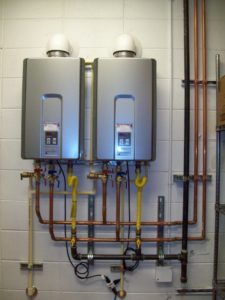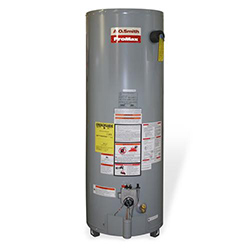 Tankless water heaters heat water directly without the use of a storage tank. When a hot water tap is turned on, cold water travels through a pipe into the unit. Either a gas burner or an electric element heats the water. As a result, tankless water heaters deliver a constant supply of hot water.
Tankless water heaters heat water directly without the use of a storage tank. When a hot water tap is turned on, cold water travels through a pipe into the unit. Either a gas burner or an electric element heats the water. As a result, tankless water heaters deliver a constant supply of hot water.
These heaters also save space with a compact design, last longer and are better for the environment because a rusty tank doesn’t end up in the landfill.
With a tankless heater, you won’t have the breakdown issue with water on the floor.
Is a tankless water heater right for you?
Here are some things to consider before making the decision to go tankless:
Demand: Do you want a unit to heat water in one bathroom or the entire house?
Type: Consider the requirements. An electric model will need the proper voltage, amperage and circuit breaker. Gas-fired models need to be vented.
Location: They must be within roughly 50 feet from a power source, and can be mounted on an interior or exterior wall.
The pros of a tankless water heater:
- Saves money in the long run – According to Energy.gov, “For homes that use 41 gallons or less of hot water daily, demand (or tankless) water heaters can be 24%–34% more energy efficient than conventional storage tank water heaters.”
- Doesn’t take up much space – Tankless water heaters are small and can be installed in more places—even on an outside wall.
- Longer life – Lasts 20+ years. Almost double a traditional water heater’s life.
- Delivers hot water on demand – Provides two to three gallons of hot water per minute on demand.
The cons of a tankless water heater:
- Higher initial cost – Costs $2800 to $4500 installed.
- Retrofitting adds to upfront cost – Replacing a traditional water heater with a tankless system is more complicated. So that increases the installation cost even further.
Which water heater should I choose?
Pick the water heater that best fits your water usage, lifestyle situation, and budget.
According to Energy.gov, an Energy Star tankless water heaters can save you about $100 annually. So if you can handle the high initial costs, you can save more money in the long run by switching to tankless. Tankless can also be a good choice for large families because you have more people consistently using more hot water. However, a traditional water heater may make more sense if you are on a limited income and need a quick replacement.
 A traditional tank type water heater typically stores and preheats 30-50 gallons of water in a tank. That preheated water is used whenever someone showers, does the laundry or washes dishes. The tank then refills to be reheated once again.
A traditional tank type water heater typically stores and preheats 30-50 gallons of water in a tank. That preheated water is used whenever someone showers, does the laundry or washes dishes. The tank then refills to be reheated once again.
The pros of a traditional water heater are:
- Lower initial cost – A traditional water heater installation can be half as much as a tankless water heater.
- Easy and inexpensive to replace – Less installation complications means that there’s less that can go wrong.
The cons of a traditional water heater are:
- Higher utility bill – They heat and reheat water at a pre-set temperature regardless of your water needs. This increases your utility bill—especially during the winter.
- Bigger and harder to place – They occupy more room and can’t be placed outside.
- Can run out of hot water – Ever been the last in your family to get the shower? It can be a chilling experience. This problem can be avoided by purchasing a larger tank (although that will mean higher energy costs.
- Shorter life – A traditional water heater typically lasts 10-15 years. This means that you have to buy them twice as often as a tankless water heater.
